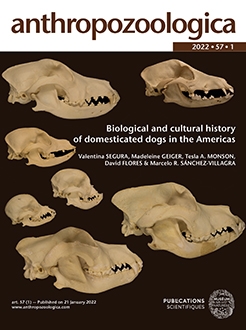Domestication had a dramatic influence on the cultural evolution of human histories, and on the biological evolution of domesticated species. Domestic dogs occurred earlier in the Americas than other domesticated animals. Older records in the continent come from North America, dated 11 000-8400 years BP, and in the Andes from 5600-5000 years BP. In order to present an overview of human-dog interaction in the Americas, and to identify gaps in knowledge of this subject, we reviewed 178 publications on zooarchaeological record of burials, genetics, morphology, and ethnological information of American dogs, revisiting the history and interactions across the continent. There is no evidence of an in situ dog initial domestication. Pre-Columbian diversity in North America includes at least three varieties, whereas in South America six varieties were documented. Historical descriptions of phenotypes (e.g., humped dog) may represent an expression associated with mutations. We find that archaeological, historical, and ethnographic records reveal non-traditional uses and hybridizations with other canids. For example, the Coast Salish people exploited woolly dogs for manufacturing blankets. Dog acquisition by some Amazonian cultures began towards the end of the nineteenth century. Overall more than 41 dog breeds originated in the Americas and are currently recognized by kennel clubs. The main gap in knowledge points to the relationships between American breeds, local hybridizations, migratory routes of dogs following Indigenous peoples' social networks, historical-cultural contexts, and quantification of morphological diversity. North and Central American dogs have been more intensively studied than those from the Amazon regions or Patagonia. We find that the history of domestication in the Americas is far from simple and integrative studies are needed.
How to translate text using browser tools
21 January 2022
Biological and cultural history of domesticated dogs in the Americas
Valentina Segura,
Madeleine Geiger,
Tesla A. Monson,
David Flores,
Marcelo R. Sánchez-Villagra
ACCESS THE FULL ARTICLE
It is not available for individual sale.
This article is only available to subscribers.
It is not available for individual sale.
It is not available for individual sale.

Anthropozoologica
Vol. 57 • No. 1
January 2022
Vol. 57 • No. 1
January 2022




